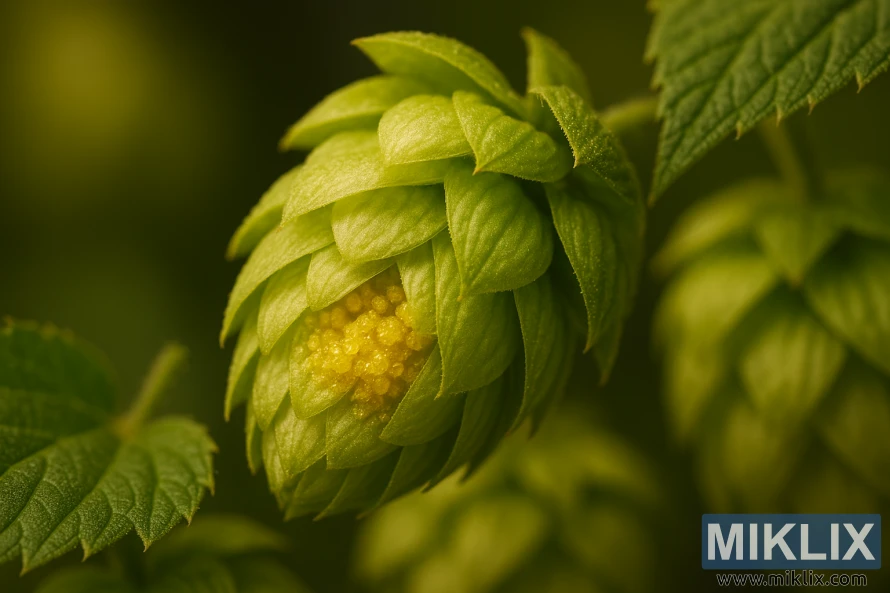Image: Macro View of Cashmere Hop Cone with Lupulin Glands
Published: October 25, 2025 at 4:18:32 PM UTC
A high-resolution macro photograph of a Cashmere hop cone, highlighting its green bracts and golden lupulin glands that define its aromatic brewing qualities.
The image is a striking macro photograph of a Cashmere hop cone, captured in exquisite detail and illuminated with warm, naturalistic lighting. At first glance, the hop cone dominates the frame with its vibrant green bracts layered tightly over one another, creating a structure that resembles the overlapping scales of a pinecone yet softer and more delicate. The photographer’s use of shallow depth of field isolates the subject against a blurred, velvety background of darker greens, ensuring that every nuance of the hop cone’s structure draws the viewer’s attention.
In the very foreground, the image reveals the heart of the cone where the bracts begin to part slightly, unveiling the golden-yellow lupulin glands nestled within. These tiny, resinous spheres glisten under the light, as though encrusted with microscopic crystals. Their texture and translucence hint at their role in producing the alpha acids and essential oils that define Cashmere hops’ complex flavor profile. The glands’ golden shimmer evokes richness and intensity, a subtle nod to the brewing alchemy they enable—transforming beer with notes of citrus, melon, coconut, and herbal bitterness.
The middle ground of the cone draws attention to its surface texture. Each bract is slightly ridged, with fine veins running lengthwise, emphasizing the hop’s organic intricacy. Soft lighting accentuates these delicate ridges, casting tiny shadows that create a tactile impression—one almost feels the velvety, slightly resinous surface of the cone simply by looking at it. The overlapping scales form a natural spiral pattern, giving the cone a sense of symmetry and rhythm, a visual reminder of the biological precision in plant structures.
The blurred background, which consists of additional hop leaves and partially out-of-focus cones, contributes to the composition without distracting from the focal point. It provides context—this cone is not solitary but part of a larger, thriving plant, climbing and spreading under the trellis of a hop yard. Yet, by blurring these secondary elements, the image emphasizes intimacy and closeness, drawing the viewer into a microscopic world where the hop’s aromatic essence becomes a visual phenomenon.
The warm, golden hue of the lighting plays a vital role in the mood of the photograph. It transforms the hop cone from a mere agricultural product into a subject of reverence, highlighting not just its physical beauty but its cultural and economic significance. Brewers and beer enthusiasts alike recognize this moment: the reveal of lupulin crystals is the heart of hop selection, the very thing that dictates the hop’s contribution to aroma, bitterness, and flavor.
Altogether, the photograph is both scientific and artistic. It communicates the hop cone’s structural biology while also celebrating its symbolic importance in craft beer culture. By focusing so tightly on one cone, the photographer captures not just an ingredient but a story—of cultivation, tradition, chemistry, and flavor—all encapsulated in a single luminous blossom.
The image is related to: Hops in Beer Brewing: Cashmere

